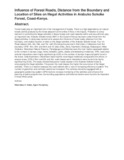Influence of Forest Roads, Distance from the Boundary and Location of Sites on Illegal Activities in Arabuko Sokoke Forest, Coast-Kenya
Abstract
Forest roads play an important role in the management of forests. There is a high dependency on natural forests and its products by the forest adjacent communities (FACs) in the tropics. Protection is a key element in controlling the illegal activities in these forests and road networks within and around them play an important role. Arabuko Sokoke forest (ASF) in the Coast of Kenya has been under threat from the illegal activities. A study was carried out to assess the influence of forest roads, distance from the boundary, and relative location of sites on the illegal activities of the Arabuko Sokoke forest. Four (4) Road classes (20c, 40c, 50c, and 75c.-with 20c being the poorest in that order), 3 distances from the boundary (DFB -1km, 2km and 3km) and 10 sites (Dida, Jilore, Kaembeni, Malanga, Matsangoni, Mida /Arabuko, Mwambani Nature Reserve, Pahalipeupe and Sokoke) were the main factors assessed relative to the number of stumps, traps, herbs collection, paths, stacks and debarking incidences. DFB, road class and site interactions were highly significant (p<0.05) on the number of stumps, traps and paths found in the forest. Dida>Kaembeni> Mwambani sites had the most illegal incidences compared to the others. In several areas, DFB of 3km and 20c and 40c road-classes were interactions were found to be highly significant (p<0.05). The study showed that poorer roads classes in the Arabuko Sokoke forest is encouraging the illegal activities. The poorer the road classes the higher the occurrence of the illegal activities. There is a need to reassess the road network with a view of increasing efficiency of patrol. The number of patrolmen and vehicles need to be increased. The vehicles should be equipped with a geographic positioning system (GPS) tools to increase monitoring of the activities and enhance the planning of patrol programmes. Surrounding populations and historical factors were found to be important in those three areas.
URI
https://doi.org/10.11648/j.ajaf.20200806.11https://www.sciencepublishinggroup.com/journal/paperinfo?journalid=218&doi=10.11648/j.ajaf.20200806.11
http://ir-library.mmust.ac.ke:8080/xmlui/handle/123456789/1940
Collections
- Journal Articles [411]

